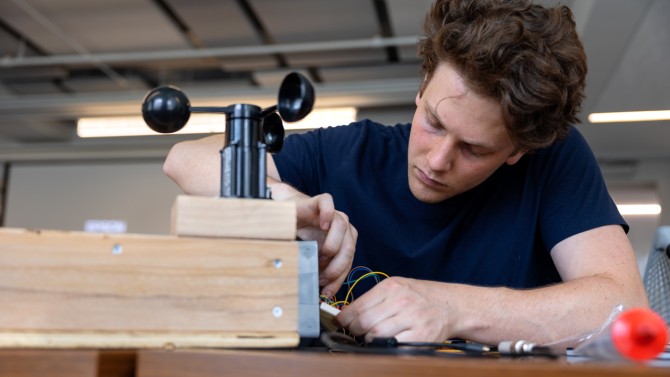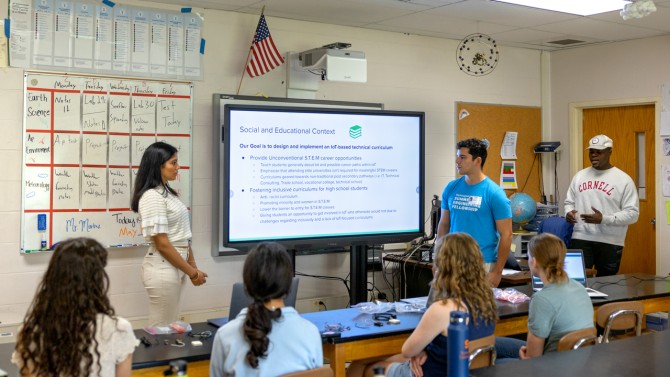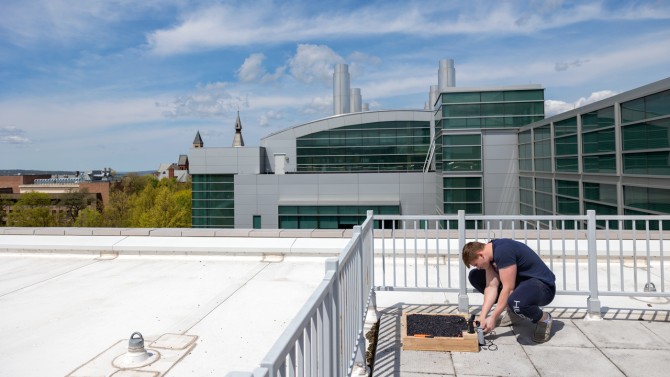
Sruti Yanamandra ’22, a master’s student in mechanical engineering, introduces Internet of Things technology to students at Geneva High School.
Students use the Internet of Things to connect, inspire
By Caitlin Hayes, Cornell Chronicle
Six weeks into Professor Max Zhang’s Internet of Things (IoT) course, he holds a graduation ceremony, complete with music, certificates and photos – because, after a crash course in how to build, code and extract data from sensors, the students are ready for the course’s next objective: helping the community.
“The course asks the students to figure out how to use IoT to understand society, so the work they do has social impact,” said Zhang, the Irving Porter Church Professor in Cornell Engineering’s Sibley School of Mechanical and Aerospace Engineering and the Kathy Dwyer Marble and Curt Marble Faculty Director at the Cornell Atkinson Center for Sustainability. “Engineering curriculums usually focus on results – your grades depend on results – and we don’t pay attention to relationships, how to build a mutual relationship, how to build trust. The course asks students to do both.”
The class is part of a larger project, funded by the National Science Foundation, to design and implement a statewide IoT network in New York, using a form of low-frequency radio to provide services in areas without cellular or broadband access, helping to bridge the digital divide. Zhang’s course, initially funded by Cornell’s David M. Einhorn Center for Community Engagement, gives students a hands-on role.
Zhang also received support from Cornell Engineering’s Shen Fund for Social Impact to create a student project team, EngagedIoT, to sustain community engagement efforts.
One of the course’s six teams, working with partners in the Cayuga Health System, is developing a device that monitors blood pressure and sends data directly to health care providers in areas without internet access – which Cayuga Health estimates could help 4,000 people. Another group built a sensor that measures the location and depth of potholes to help the Ithaca Department of Public Works. A third group of students is taking the IoT technology into the classroom at Geneva High School, in an effort to lower the barriers for STEM careers.
Other projects include the development of sensors to monitor weather and soil conditions at a Geneva winery, a food cabinet that can notify Mutual Aid Tompkins when it needs restocking, and a prototype that monitors road conditions for the Tompkins County Highway Department.
“IoT is a great way of taking a step back and seeing how engineering can really effect positive change in the world,” said Sruti Yanamandra ’22, a master’s student in mechanical engineering. “It brings you back to why you wanted to become an engineer in the first place. This class has helped me experience that.”
Yanamandra wants to bring that sense of excitement and impact to a younger generation at Geneva High School, to help solve a problem she’s seen in her own life: She’s watched many of her peers – especially her female peers – back away from majors or careers in STEM.
“Whether it’s a lack of confidence or a lack of resources, or preconceptions that you need to be at a certain level or get a certain degree, something is holding people back,” Yanamandra said.
When Yanamandra’s group met with Geneva High administrators and teachers, they echoed her concerns: they struggled to help students overcome real or perceived barriers to STEM.
IoT, the group thought, could be the perfect gateway.
“You can use a temperature sensor, a humidity sensor, soil sensor, and then you can analyze the data, create graphs; it’s all-encompassing,” Yanamandra said. “But you don’t need a ton of prior knowledge to start using it.”
After distributing a survey to students, Yanamandra and her team developed a pilot lesson for a student environmental group at the high school, the Green Club. The student group learned about two types of temperature sensors and discussed possible applications for projects within and beyond the Green Club, including using the sensors to establish a garden.
“All of the sensors we use are very integral to the types of projects these kids like to work on,” said Ini Adeleye ’23, a mechanical engineering major in Cornell Engineering. “So, one of the cool things is that we’re not just taking an arbitrary aspect of STEM, but something that is directly applicable to things they’re already passionate about.”
“They set it up in a way that gives our students a voice,” said Kirsten Abbott, a chemistry teacher at Geneva High. “It’s what education is all about – finding out where people are and where they need to be. Now, within a span of weeks, they’re also following through and making sure that the technology is in the hands of the students. It’s very impactful.”
In other projects, the accessibility of IoT has allowed for direct application – with students developing or improving devices and seeing results quickly. Jason Manning, a doctoral student in biomedical engineering, participated in the project, new this semester, on monitoring potholes – and said it was refreshing to be able to build a device and deploy it immediately.
“You’re almost never going to take a medical device from a biomedical engineering class and be able to do something applied with it because of all the regulations,” Manning said. “It was definitely different to implement this pretty directly and get design feedback so quickly from the Department of Public Works.”
Manning’s group developed a prototype that sits in a vehicle and measures acceleration and location, which allows it to detect when and where the car hits a pothole. When they tested it on Ithaca’s roads, they were able to create a map of potholes, ranked in terms of severity. While still in the early stages, these devices could be deployed in municipal vehicles, garbage or recycling trucks or snowplows, that traverse every road of the city, to give the city a detailed map without additional monitoring efforts.
For many students, the IoT course was their first opportunity to work with partners in the community – and many noted that the ongoing nature of the projects, from one semester to the next, allows for real, long-term impact.
“It’s a very holistic class in the sense that you are getting the technical aspects as well as a big overview of the system,” said Merrill Shen, a master’s student in computer science who worked on the blood pressure monitors. “But I think what’s much more nuanced is that you have this soft side, where you’re engaging with the community as well as previous alumni who worked on it, making sure you’re asking the right questions.”
Working with real problems in the community also forced students to be adaptable. Shen’s group pivoted from previous teams’ work developing a glucose monitor when their partners at Cayuga Health said a blood pressure monitor would be more useful.
“It’s been a very good opportunity to understand what it’s like to work on a team, with real stakeholders, with community members who really stand to benefit,” Shen said.
Students said Zhang’s passion for community impact and engagement provides an inspiring model.
“He taught us that success doesn’t mean that things always go as planned,” said Nathaniel Garcia ’23, a mechanical engineering major in Cornell Engineering and member of the STEM outreach team. “If we’ve built a strong relationship – that’s a way to measure success.”
Media Contact
Abby Kozlowski
Get Cornell news delivered right to your inbox.
Subscribe




